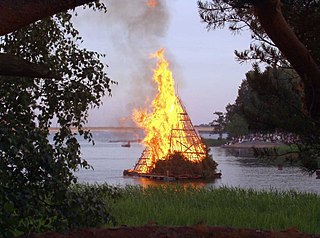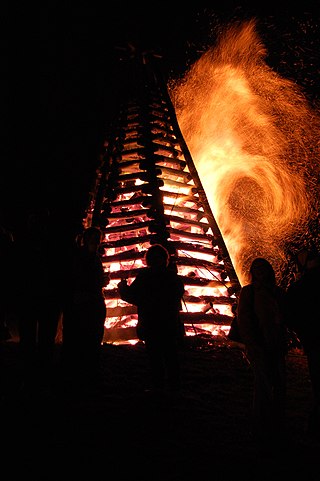
Halloween or Hallowe'en is a celebration observed in many countries on 31 October, the eve of the Western Christian feast of All Saints' Day. It begins the observance of Allhallowtide, the time in the liturgical year dedicated to remembering the dead, including saints (hallows), martyrs, and all the faithful departed.

May Day is a European festival of ancient origins marking the beginning of summer, usually celebrated on 1 May, around halfway between the spring equinox and summer solstice. Festivities may also be held the night before, known as May Eve. Traditions often include gathering wildflowers and green branches, weaving floral garlands, crowning a May Queen, and setting up a Maypole, May Tree or May Bush, around which people dance. Bonfires are also part of the festival in some regions. Regional varieties and related traditions include Walpurgis Night in central and northern Europe, the Gaelic festival Beltane, the Welsh festival Calan Mai, and May devotions to the Blessed Virgin Mary. It has also been associated with the ancient Roman festival Floralia.

Samhain is a Gaelic festival on 1 November marking the end of the harvest season and beginning of winter or "darker half" of the year. Celebrations begin on the evening of 31 October, since the Celtic day began and ended at sunset. This is about halfway between the autumnal equinox and winter solstice. It is one of the four Gaelic seasonal festivals along with Imbolc, Beltaine and Lughnasa. Historically it was widely observed throughout Ireland, Scotland, Galicia and the Isle of Man. A similar festival was held by the Brittonic Celtic people, called Calan Gaeaf in Wales, Kalan Gwav in Cornwall and Kalan Goañv in Brittany.

Halloween costumes are costumes worn on Halloween, a festival which falls on October 31. An early reference to wearing costumes at Halloween comes from Scotland in 1585, but they may pre-date this. There are many references to the custom during the 18th and 19th centuries in the Celtic countries of Scotland, Ireland, Mann and Wales. It has been suggested that the custom comes from the Celtic festivals of Samhain and Calan Gaeaf, or from the practise of "souling" during the Christian observance of Allhallowtide. The Christian tradition of acknowledging the danse macabre is also suggested as the origin of dressing up on Halloween Dressing up is not strictly restricted to Halloween among Christians, with similar practices being observed on holidays like Christmas. Halloween costumes are traditionally based on frightening supernatural or folkloric beings. However, by the 1930s costumes based on characters in mass media such as film, literature, and radio were popular. Halloween costumes have tended to be worn mainly by young people, but since the mid-20th century they have been increasingly worn by adults also.

A bonfire is a large and controlled outdoor fire, used either for informal disposal of burnable waste material or as part of a celebration.

Walpurgis Night, an abbreviation of Saint Walpurgis Night, also known as Saint Walpurga's Eve, is the eve of the Christian feast day of Saint Walpurga, an 8th-century abbess in Francia, and is celebrated on the night of 30 April and the day of 1 May. This feast commemorates the canonization of Saint Walpurga and the movement of her relics to Eichstätt, both of which occurred on 1 May 870.
Midsummer is a celebration of the season of summer usually held at a date around the summer solstice. It has pagan pre-Christian roots in Europe.

Allhallowtide, Hallowtide, Allsaintstide, or the Hallowmas season, is the Western Christian season encompassing the triduum of All Saints' Eve (Halloween), All Saints' Day and All Souls' Day, as well as the International Day of Prayer for the Persecuted Church and Remembrance Sunday in some traditions. The period begins on 31 October annually. Allhallowtide is a "time to remember the dead, including martyrs, saints, and all faithful departed Christians." The present date of Hallowmas and thus also of its vigil (Hallowe'en) was established for Rome perhaps by Pope Gregory III (731–741) and was made of obligation throughout the Frankish Empire by Louis the Pious in 835. Elsewhere, other dates were observed even later, with the date in Ireland being 20 April. In the early 11th century, the modern date of All Souls' Day was popularized, after Abbot Odilo established it as a day for the monks of Cluny and associated monasteries to pray for the dead.

Saint John's Eve, starting at sunset on 23 June, is the eve of celebration before the Feast Day of Saint John the Baptist. The Gospel of Luke states that John was born six months before Jesus; therefore, the feast of John the Baptist was fixed on 24 June, six months before Christmas according to the old Roman calculation. This feast day is one of the very few saints' days which commemorates the anniversary of the birth, rather than the death, of the saint being honored.
The Bonfires of Saint John are a traditional and popular festival celebrated around the world during Midsummer, which takes place on the evening of 23 June, St. John's Eve. It is customary in many cities and towns in Spain; the largest one takes place in Alicante, where it is the most important festival in the city. The biggest celebration in Portugal is held in Oporto, where it is known as the Festa de São João do Porto. In South America, the biggest celebration takes place in the northeastern states of Brazil, where it is known as Festa Junina.

Guy Fawkes Night, also known as Guy Fawkes Day, Bonfire Night and Fireworks Night, is an annual commemoration observed on 5 November, primarily in Great Britain, involving bonfires and fireworks displays. Its history begins with the events of 5 November 1605 O.S., when Guy Fawkes, a member of the Gunpowder Plot, was arrested while guarding explosives the plotters had placed beneath the House of Lords. The Catholic plotters had intended to assassinate Protestant king James I and his parliament. Celebrating that the king had survived, people lit bonfires around London; and months later, the Observance of 5th November Act mandated an annual public day of thanksgiving for the plot's failure.

Golowan is the Cornish language word for the Midsummer celebrations in Cornwall, UK; widespread prior to the late 19th century and most popular in the Penwith area and in particular Penzance and Newlyn. The celebrations were centred on the lighting of bonfires and fireworks and the performance of associated rituals. The midsummer bonfire ceremonies were revived at St Ives in 1929 by the Old Cornwall Society and since then spread to other societies across Cornwall, as far as Kit Hill near Callington. Since 1991 the Golowan festival in Penzance has revived many of these ancient customs and has grown to become a major arts and culture festival; its central event 'Mazey Day' now attracts tens of thousands of people to the Penzance area in late June.

Kupala Night, also called Ivanа Kupala, is a traditional Slavic holiday that was originally celebrated on the shortest night of the year, which is on 21-22 or 23-24 of June and in Eastern Slavic countries according to traditional Julian calendar on the night between 6 to 7 July. Calendar-wise, it is opposite to the winter holiday Koliada. The celebration relates to the summer solstice when nights are the shortest and includes a number of Slavic rituals. It involves herb collecting, bonfire lighting, and bathing in the river.
Jaanipäev and Jaaniõhtu, also Jaanilaupäev are the most important days in the Estonian calendar, apart from Christmas. The short summer seasons with long days and brief nights hold special significance for the people of Estonia. Jaanipäev is celebrated on the night between June 23 and 24, the Western Christian feast of the nativity of Saint John the Baptist, which is a few days after the summer solstice.

Parkin is a gingerbread cake traditionally made with oatmeal and black treacle, which originated in northern England. Often associated with Yorkshire, it is widespread and popular elsewhere, notably in Lancashire. Parkin is baked to a hard cake but with resting becomes moist and even sometimes sticky. There are regional differences, for example in Hull and East Yorkshire, it has a drier, more biscuit-like texture than in other areas whereas in Lancashire it is generally made with golden syrup rather than the treacle used elsewhere. Parkin is traditionally eaten on Guy Fawkes Night, 5 November, but is also enjoyed throughout the winter months. It is baked commercially throughout Yorkshire, but is mainly a domestic product in other areas.
Lists of holidays by various categorizations.

Halloween is a celebration observed on October 31, the day before the feast of All Hallows, also known as Hallowmas or All Saint's Day. The celebrations and observances of this day occur primarily in regions of the Western world, albeit with some traditions varying significantly between geographical areas.

Bonfire Night is a name given to various annual celebrations characterised by bonfires and fireworks. The event celebrates different traditions on different dates, depending on the country. Some of the most popular instances include Guy Fawkes Night in Great Britain, which is also celebrated in some Commonwealth countries; Northern Ireland's Eleventh Night, and 5 November in Newfoundland and Labrador. In various parts of Ireland, Bonfire Nights are held on Saint John's Eve, Bealtaine eve and Halloween. In Scandinavia it is known as Walpurgis Night and in Denmark and Norway also sankthansaften. In Finland bonfires are lit on the eve of Juhannus. Saint John's Eve is also a very important celebration in Spain and Northern Portugal. Several other cultures also include night-time celebrations involving bonfires and/or fireworks.
The phrase English festivals cover a number of festivals which are Christian and secular that are traditionally celebrated in England. Most festivals are observed throughout England but some, such as Oak Apple Day, Souling, Rushbearing, Bawming the Thorn, and Hocktide are local to certain regions.













